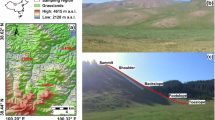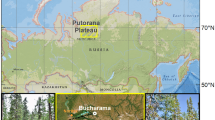Abstract
The prediction of soil C stocks across the landscape has been increasingly studied in many areas of the world. Soil organic C storage in mountain areas is highly heterogeneous, mainly as a result of local-scale variability in the soil environment (topography, stoniness, parent material) and microclimate. The aims of the present study are to estimate soil organic C stocks (SOCS) in mineral soils of high-altitude grasslands of the Pyrenees and determine whether climatic and topographic variables can be used as predictors of SOCS and organic C content in the surface soil horizons of these ecosystems. For that purpose we sampled 35 soil profiles in subalpine and alpine grasslands including a range of altitudes, slopes and aspects. We analysed the soils for stoniness, bulk density, total C, texture, and C-to-N ratio and determined topographical variables. We used georeferenced climatic information for climatic descriptions of the sites. SOCS were highly correlated with soil depth. However, we were not able to predict soil depth by using environmental and topographic variables. In spite of this fact, altitude and aspect explained 41.2% of the SOCS variability while summer temperature and precipitation combined with aspect explained 56.9% of the variability of the organic C content of the surface layer (OC). The SOCS were low at high altitudes, probably as a result of an overall temperature limitation of net primary productivity. Under these conditions, the effect of aspect was small. The highest SOCS occurred at the lowest altitudes for ENE or WNW aspects, showing sharper decreases towards the south than to the north. The harsh climatic conditions and low-plant productivity that occur at the northern slopes reduced SOCS at the highest altitudes. In contrast, southern aspects showed similar organic C content along the altitudinal gradient. The OC variability in the surface soils not explained by climatic or topographic variables was partially related to the characteristics of soil organic matter, which may depend on the plant communities.




Similar content being viewed by others
References
Agustí-Panareda A, Thompson R (2002) Reconstructing air temperature at eleven remote alpine and arctic lakes in Europe from 1781 to 1997 AD. J Paleolimnol 28:7–23
Bardgett R (2005) The biology of soil. A community and ecosystem approach. Oxford University Press, Oxford
Brooks PD, Williams MW (1999) Snowpack controls on nitrogen cycling and export in seasonally snow-covered catchments. Hydrol Process 13:2177–2190
Ganuza A, Almendros G (2003) Organic carbon storage of the Basque Country (Spain): the effect of climate, vegetation type and edaphic variables. Biol Fertil Soils 37:154–162
Grieve IC (2000) Effects of human disturbance and cryoturbation on soil iron and organic matter distributions and on carbon storage at high elevations in the Cairngorm Mountains, Scotland. Geoderma 95:1–14
Hassink J (1997) The capacity of soils to preserve organic C and N by association with clay and silt particles. Plant Soil 191:77–87
Hitz C, Egli M, Fitze P (2001) Below-ground and above-ground production of vegetational organic matter along a climosequence in alpine grasslands. J Plant Nutr Soil Sci 164:389–397
Hobbie SE, Schimel JP, Trumbore SE, Randerson JR (2000) Controls over carbon storage and turnover in high-latitude soils. Glob Change Biol 6:196–210
Hontoria C, Rodríguez-Murillo JC, Saa A (1999) Relationships between soil organic carbon and site characteristics in Peninsular Spain. Soil Sci Soc Am J 63(3):614–621
Jobbágy EG, Jackson RB (2000) The vertical distribution of soil organic carbon and its relation to climate and vegetation. Ecol Appl 10(2):423–436
Jones RJA, Hiedere R, Rusco E, Loveland PJ, Montanarella L (2003) Top soil organic C in Europe. In: Proceedings of the 4th European congress on regional geoscientific cartography and information systems, Bologna, pp 249–251
Kikvidze Z, Pugnaire FI, Brooker RW, Choler P, Lortie CJ, Michalet R, Callaway RM (2005) Linking patterns and processes in alpine plant communities: a global study. Ecology 86(6):1395–1400
Lang R (1915) Versuch einer exakten Klassifikation der Boden in klimatischer Hinsicht. Int Mitt für Bodenkunde 5:312–346
Leifeld J, Bassin S, Fuhrer J (2005) Carbon stocks in Swiss agricultural soils predicted by land use, soil characteristics, and altitude. Agric Ecosyst Environ 105:255–266
Miller A, Amundson R, Burke IC, Yonker C (2004) The effect of climate and cultivation on soil organic C and N. Biogeochemistry 67:57–72
Mokany K, Raison RJ, Prokushkin S (2006) Critical analysis of root : shoot ratios in terrestrial biomes. Glob Change Biol 12:84–96
Müller T, Höper H (2004) Soil organic matter turnover as a function of the soil clay content: consequences for model applications. Soil Biol Biochem 36:877–888
Neilsen CB, Groffman PM, Hamburg SP, Driscoll CT, Fahey TJ, Hardy JP (2001) Freezing effects on carbon and nitrogen cycling in northern hardwood forest soils. Soil Sci Soc Am J 65:1723–1730
O’Lear HA, Seastedt TR (1994) Landscape patterns of litter decomposition in alpine tundra. Oecologia 99(1–2):95–101
Prichard SJ, Peterson DL, Hammer RD (2000) Carbon distribution in subalpine forests and meadows of the Olympic Mountains, Washington. Soil Sci Soc Am J 64:1834–1845
Rey Benayas JM, Sánchez-Colomer MG, Escudero A (2004) Landscape- and field-scale control of spatial variation of soil processes in Mediterranean montane meadows. Biogeochemistry 69:207–225
Rodeghiero M, Cescatti A (2005) Main determinants of forest soil respiration along an elevation/temperature gradient in the Italian Alps. Glob Change Biol 11:1024–1041
Rodríguez-Murillo JC (2001) Organic carbon content under different types of land use and soil in peninsular Spain. Biol Fertil Soils 33:53–61
Schimel DS (1995) Terrestrial ecosystems and the carbon cycle. Glob Change Biol 1:77–91
Sebastià MT (2004) Role of topography and soils in grassland structuring at the landscape and community scales. Bas Appl Ecol 5:331–346
Six J, Conant RT, Paul EA, Paustian K (2002) Stabilization mechanisms of soil organic matter: implications for C-saturation of soils. Plant Soil 241:155–176
Tate KR, Scott NA, Ross NJ, Parshotam A, Claydon JJ (2000) Plant effects on soil carbon storage and turnover in a montane beech (Nothofagus) forest and adjacent tussock grassland in New Zealand. Aust J Soil Res 38:685–698
Townsend AR, Vitousek PM, Trumbore SE (1995) Soil organic matter dynamics along gradients in temperature and land use on the island of Hawaii. Ecology 76(3):721–733
White RP, Murray S, Rohweder M (2000) Pilot analysis of global ecosystems. Grassland ecosystems. World Resources Institute, Washington, DC
Vinton MA, Burke IC (1997) Contingent effects of plant species on soils along a regional moisture gradient in the Great Plains. Oecologia 110:393–402
Acknowledgements
This work was funded in part by the European Commission under the EMERGE (EVK1-CT-1999-00032) and CARBOMONT (EVK2-CT-2001-00125) projects, by the Spanish Ministry of Science and Technology under the CARBOPAS (REN2002-04300-C02-02) project and the Spanish Interministerial Committee on Science and Technology (grant REN2000-0889/GLO).
Author information
Authors and Affiliations
Corresponding author
Rights and permissions
About this article
Cite this article
Garcia-Pausas, J., Casals, P., Camarero, L. et al. Soil organic carbon storage in mountain grasslands of the Pyrenees: effects of climate and topography. Biogeochemistry 82, 279–289 (2007). https://doi.org/10.1007/s10533-007-9071-9
Received:
Accepted:
Published:
Issue Date:
DOI: https://doi.org/10.1007/s10533-007-9071-9




